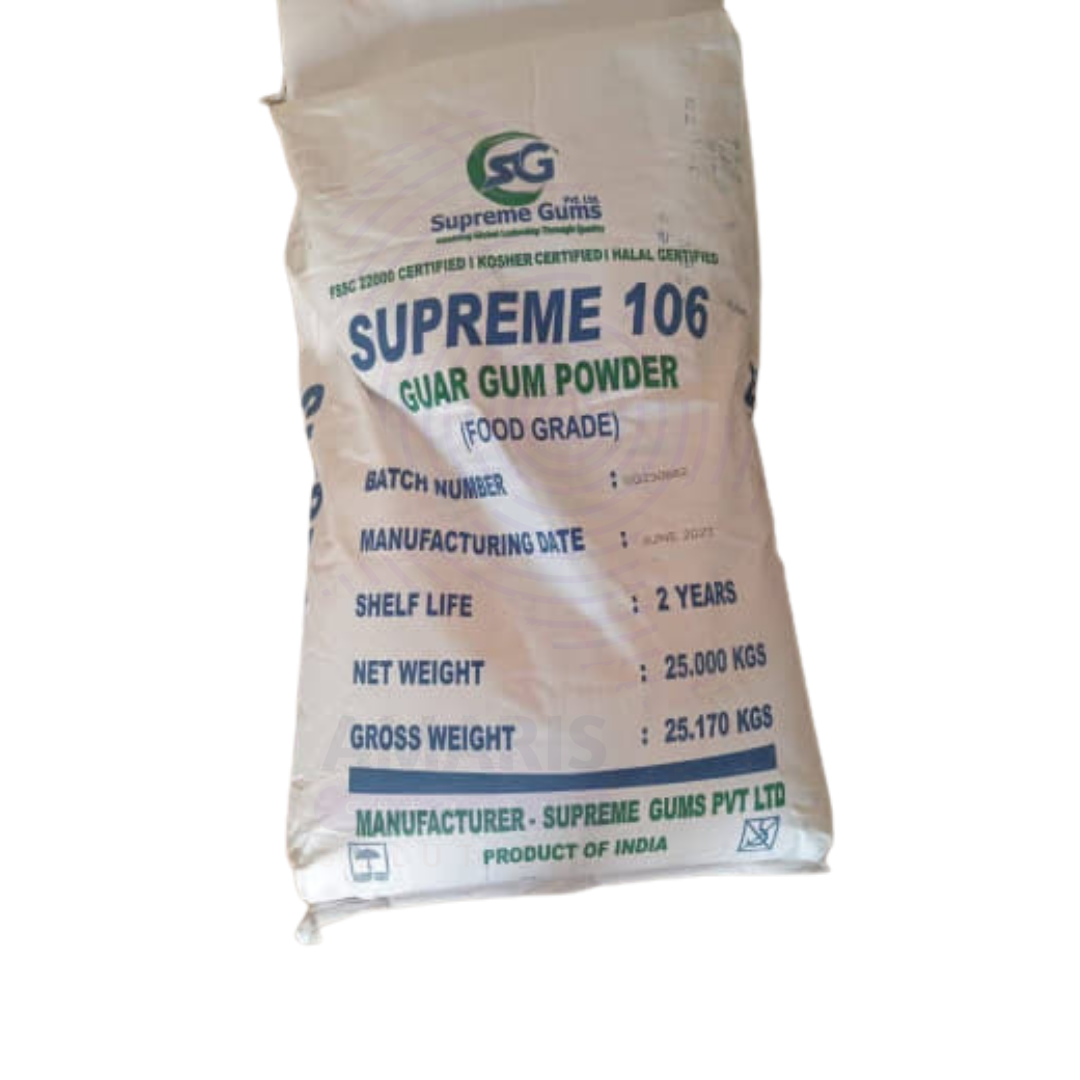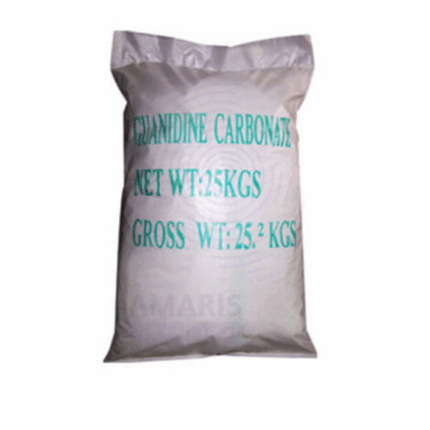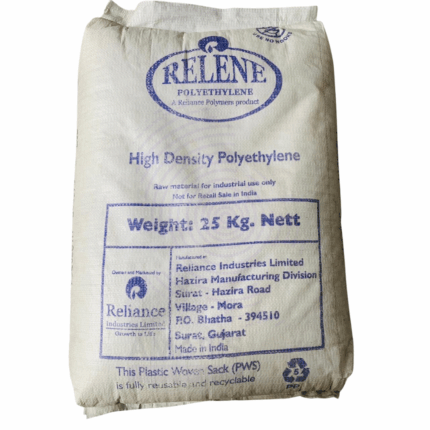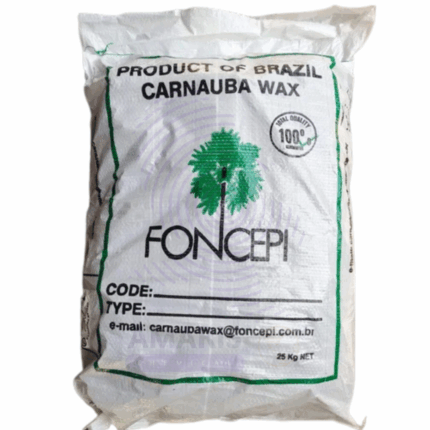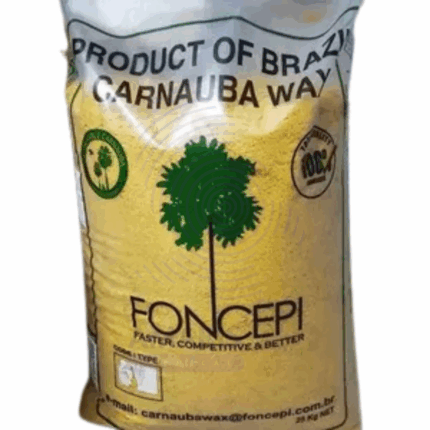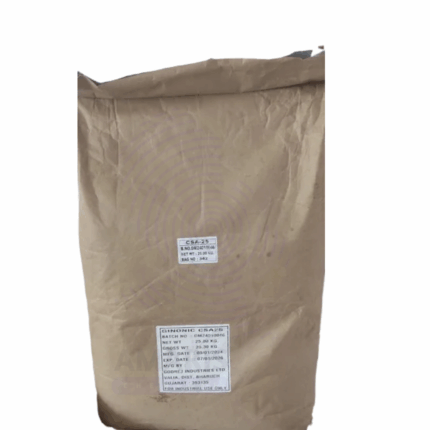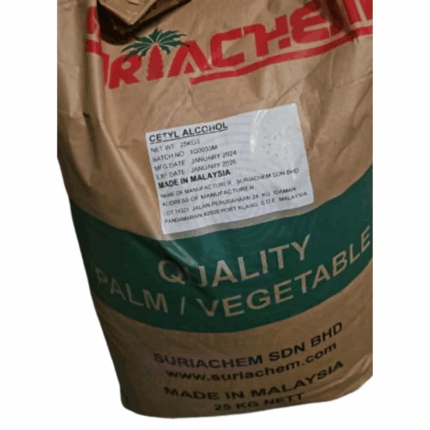Guar Gum
Whatsapp Order
Guar Gum is a natural polysaccharide extracted from the endosperm of the guar bean (Cyamopsis tetragonoloba). It appears as an off-white to cream-colored powder with a neutral odor and bland taste. Guar Gum is a galactomannan composed mainly of mannose and galactose units, known for its excellent water-binding, thickening, and stabilizing properties. It forms highly viscous solutions even at low concentrations, making it a versatile hydrocolloid used widely across food, pharmaceutical, cosmetic, oilfield, and industrial applications.
Categories: Animal Feed Additives, Emollients, Emulsifiers, Excipients, Hydraulic Fracturing Fluids, Nutraceutical Ingredients (pharmaceutical), Nutrient Supplements, Soil Conditioners, Thickeners
Tags: Cosmetic Grade Guar Gum, Food additive, Guar Gum, Guar Gum Powder, Natural Thickener, Oil Drilling Additive
Description
Table of Contents
Toggle
Guar Gum
Primary Uses
- Food Industry
- Thickening agent in sauces, soups, gravies, and dairy products like yogurt and ice cream.
- Functions as a stabilizer and emulsifier in dressings, bakery fillings, and beverages to improve texture and shelf life.
- Used as a dietary fiber source and fat replacer in low-calorie and gluten-free food formulations.
- Acts as a binding agent in meat products and bakery goods.
- Helps improve freeze-thaw stability and prevents ice crystal formation in frozen foods.
- Pharmaceutical Industry
- Used as a binder and disintegrant in tablet formulations for controlled drug release.
- Functions as a thickening and suspending agent in liquid oral and topical medications.
- Incorporated in capsule formulations to improve consistency and stability.
- Acts as a film-former and stabilizer in pharmaceutical gels and creams.
- Cosmetics and Personal Care
- Serves as a viscosity enhancer in shampoos, conditioners, lotions, and creams.
- Acts as a stabilizer and emulsifier in cosmetic formulations to improve texture and spreadability.
- Used in toothpaste formulations for gel formation and suspension of abrasive particles.
- Provides moisture retention and skin feel improvement in personal care products.
- Oil and Gas Industry
- Applied as a friction reducer, thickener, and stabilizer in hydraulic fracturing fluids and drilling muds to improve fluid properties and suspension of solids.
- Used in enhanced oil recovery (EOR) to increase the viscosity of injection water and improve sweep efficiency.
- Industrial Applications
- Employed in textile printing and sizing as a thickener and binder for dyes and pigments.
- Used in paper manufacturing as a retention aid and to improve paper strength and finish.
- Functions as a binder in adhesives and coatings.
- Used in explosives manufacture as a thickener for slurry explosives.
Secondary Uses
- Agriculture
- Used as a carrier and binder for fertilizers and pesticides.
- Investigated for soil conditioning and moisture retention improvement.
- Environmental Applications
- Used in wastewater treatment to aid in flocculation and sedimentation of suspended solids.
- Food Packaging
- Explored as a biodegradable film former for edible coatings and food packaging materials.
- Biomedical Applications
- Investigated for drug delivery systems and wound dressings due to its biocompatibility and film-forming ability.
PRODUCT KEY FEATURES
- Basic Identification Attributes
- Chemical Name (IUPAC): Galactomannan
- Common/Trade Name: Guar Gum
- CAS Number: 9000-30-0
- HS Code: 1302.32.00
- Molecular Formula: (C6H10O5)n (polysaccharide)
- Synonyms: Guaran; Cyamopsis gum; Guar flour
- Physical & Chemical Properties
- Physical State: Powder
- Color & Odor: Off-white to cream; bland odor and taste
- Solubility: Soluble in cold and hot water, forming viscous solutions
- pH (1% aqueous solution): 5.0–7.0 (neutral/slightly acidic)
- Viscosity: High viscosity even at low concentrations (depends on batch and molecular weight)
- Stability: Stable in dry form; viscosity can be affected by pH extremes and microbial contamination
- Safety & Hazard Attributes
- GHS Classification: Generally regarded as safe (GRAS)
- Toxicity: Non-toxic; edible and biodegradable
- Allergenicity: Low; rare reports of hypersensitivity
- Storage & Handling Attributes
- Container Type: Sealed bags, drums, or bulk containers
- Storage Conditions: Cool, dry place away from moisture and contaminants
- Shelf Life: 24 months under proper storage
- Handling Notes: Avoid dust inhalation; use dust masks if necessary
- Regulatory & Compliance Attributes
- Approved as a food additive (E412) by FDA, EFSA, and other regulatory agencies
- Complies with pharmaceutical and cosmetic ingredient standards
- Non-GMO and organic grades available
- Environmental & Health Impact
- Biodegradability: Fully biodegradable and environmentally friendly
- Ecotoxicity: Non-toxic to aquatic life
- Bioaccumulation: None expected
- Carcinogenicity/Mutagenicity: Not classified; safe for human use
SAFETY HANDLING ATTRIBUTES
- Safety Handling Precautions
- PPE Required: Dust mask, gloves, safety goggles when handling powder
- Handling Guidelines: Use in well-ventilated areas; avoid dust generation and inhalation
- Hygiene Practices: Wash hands after handling; avoid contact with eyes
- First Aid Measures
- Inhalation: Move to fresh air if respiratory discomfort occurs
- Skin Contact: Wash with soap and water; rare irritation possible
- Eye Contact: Rinse with plenty of water; seek medical attention if irritation persists
- Ingestion: Generally safe; seek medical advice if large amounts swallowed
- Firefighting Measures
- Fire Hazards: Non-flammable but combustible in dust form
- Extinguishing Media: Water spray, foam, dry chemical, or CO₂
- Combustion Products: Carbon oxides, possible traces of hydrocarbons
- Firefighter PPE: Use self-contained breathing apparatus if exposed to smoke
Related products
Carnauba Wax
Carnauba Wax is a natural vegetable wax obtained from the leaves of the Copernicia prunifera palm tree, native to northeastern Brazil. It appears as a hard, brittle, yellow to brownish-yellow wax with a faint, characteristic odor. Known as the “queen of waxes,” Carnauba Wax is prized for its exceptionally high melting point, glossy finish, and excellent hardness. It is a premium wax widely used in cosmetics, food, pharmaceuticals, automotive, and industrial applications as a natural, biodegradable alternative to synthetic waxes. Its film-forming, emulsifying, and protective properties make it highly versatile for use in coatings, polishes, and skincare products.
Carnauba Wax Prime Yellow
Carnauba Wax Prime Yellow is a premium grade of natural vegetable wax derived from the leaves of the Copernicia prunifera palm tree, predominantly found in northeastern Brazil. This wax is characterized by its bright yellow color and superior purity, making it highly valued in high-end applications. It features a hard, brittle texture with a high melting point (82–86°C) and a mild, characteristic odor. Carnauba Wax Prime Yellow offers excellent gloss, durability, and water resistance. Its natural origin, combined with exceptional film-forming and emulsifying properties, makes it a preferred choice in cosmetics, food glazing, pharmaceuticals, automotive waxes, and industrial coatings where quality and performance are paramount.
Ceteareth 25 Ginonic CSA 25
Ceteareth 25 Ginonic CSA 25 is a nonionic surfactant and emulsifier derived from the ethoxylation of cetearyl alcohol, incorporating approximately 20 ethylene oxide units per molecule. It appears as a white to off-white waxy solid or viscous liquid, depending on temperature and formulation. This emulsifier is widely used in cosmetic, pharmaceutical, and industrial formulations for its excellent ability to stabilize oil-in-water emulsions, improve texture, and enhance the sensory properties of finished products. Its high hydrophilic-lipophilic balance (HLB) makes it especially effective in forming stable emulsions and solubilizing lipophilic ingredients in aqueous phases. Ceteareth 20 is valued for its mildness, broad compatibility, and multifunctional performance.
Cetomacrogol PEG1000 (Ginonic CSA 20)
Cetomacrogol PEG (Ginonic CSA) is a polyethylene glycol-based nonionic surfactant and emulsifier with an average molecular weight of approximately 1000 Da. It appears as a white to off-white waxy solid or flakes with a neutral odor. This high-quality grade is widely used in cosmetic, pharmaceutical, and personal care formulations due to its excellent emulsifying, solubilizing, and moisturizing properties. Cetomacrogol PEG1000 (Ginonic CSA 20) facilitates stable oil-in-water emulsions, improves product texture and skin feel, and enhances the bioavailability of active ingredients. Its hydrophilic nature and compatibility with a wide range of ingredients make it a versatile additive in creams, lotions, ointments, and topical gels.
Cetyl Alcohol
Cetyl Alcohol, also known as 1-Hexadecanol or Palmityl Alcohol, is a fatty alcohol derived primarily from natural sources such as palm oil and coconut oil. It appears as a waxy, white to pale yellow solid with a faint fatty odor. Cetyl Alcohol is widely used in cosmetic, pharmaceutical, and industrial formulations due to its emollient, emulsifying, thickening, and stabilizing properties. It helps improve texture, consistency, and moisturizing effects in personal care products. Cetyl Alcohol is compatible with many ingredients, making it a versatile multifunctional ingredient.
Cetyl Stearyl Alcohol (CSA)
Cetyl Stearyl Alcohol (CSA), also known as Cetearyl Alcohol, is a blended fatty alcohol consisting primarily of cetyl (C16) and stearyl (C18) alcohols. It appears as white to pale yellow waxy flakes or pellets with a mild fatty odor. CSA is widely used in cosmetics, pharmaceuticals, and personal care products as an emollient, thickener, and co-emulsifier. It enhances texture, improves stability, and provides a smooth, velvety skin feel in formulations. Being a non-ionic surfactant, it also aids in stabilizing oil-in-water emulsions and is favored for its gentle nature on the skin and hair.
Dimethicone Silicon Oil
Dimethicone Silicon Oil, also known as polydimethylsiloxane (PDMS) or silicone oil, is a clear, odorless, and non-volatile silicone-based polymer widely used for its lubricating, anti-foaming, water-repellent, and skin-conditioning properties. It is a linear silicone polymer composed of repeating dimethylsiloxane units. Dimethicone exhibits excellent thermal stability, chemical inertness, and low surface tension, making it highly versatile in pharmaceutical, cosmetic, personal care, industrial, and food applications. It is available in various viscosities, from very low to high viscosity oils, enabling tailored formulations.
Hydroxyethyl Cellulose
Hydroxyethyl Cellulose , marketed under brand names such as Natrosol, is a non-ionic, water-soluble polymer derived from cellulose by reacting alkali cellulose with ethylene oxide. It appears as a white to off-white, free-flowing powder with excellent thickening, binding, and film-forming properties. HEC is widely used as a rheology modifier and stabilizer due to its high water retention, solubility, and compatibility with a broad range of ingredients. It is valued in many industries including cosmetics, pharmaceuticals, paints, adhesives, and personal care products.


 Preservatives(food)
Preservatives(food) Flavor Enhancers
Flavor Enhancers Acidulants
Acidulants Sweeteners
Sweeteners Antioxidants
Antioxidants Colorants(food)
Colorants(food) Nutraceutical Ingredients (food)
Nutraceutical Ingredients (food) Nutrient Supplements
Nutrient Supplements Emulsifiers
Emulsifiers
 Collectors
Collectors Dust Suppressants
Dust Suppressants Explosives and Blasting Agents
Explosives and Blasting Agents Flocculants and Coagulants
Flocculants and Coagulants Frothers
Frothers Leaching Agents
Leaching Agents pH Modifiers
pH Modifiers Precious Metal Extraction Agents
Precious Metal Extraction Agents
 Antioxidants(plastic)
Antioxidants(plastic) Colorants (Pigments, Dyes)
Colorants (Pigments, Dyes) Fillers and Reinforcements
Fillers and Reinforcements Flame Retardants
Flame Retardants Monomers
Monomers Plasticizers
Plasticizers Polymerization Initiators
Polymerization Initiators Stabilizers (UV, Heat)
Stabilizers (UV, Heat)
 Antifoaming Agents
Antifoaming Agents Chelating Agents
Chelating Agents Coagulants and Flocculants
Coagulants and Flocculants Corrosion Inhibitors
Corrosion Inhibitors Disinfectants and Biocides
Disinfectants and Biocides Oxidizing Agents
Oxidizing Agents pH Adjusters
pH Adjusters Scale Inhibitors( water)
Scale Inhibitors( water)
 Antioxidants(cosmetic)
Antioxidants(cosmetic) Emollients
Emollients Fragrances and Essential Oils
Fragrances and Essential Oils Humectants
Humectants Preservatives
Preservatives Surfactants(cosmetic)
Surfactants(cosmetic) Thickeners
Thickeners UV Filters
UV Filters
 Fertilizers
Fertilizers Soil Conditioners
Soil Conditioners Plant Growth Regulators
Plant Growth Regulators Animal Feed Additives
Animal Feed Additives Biostimulants
Biostimulants Pesticides (Herbicides, Insecticides, Fungicides)
Pesticides (Herbicides, Insecticides, Fungicides)
 Active Pharmaceutical Ingredients (APIs)
Active Pharmaceutical Ingredients (APIs) Excipients
Excipients Solvents(pharmaceutical)
Solvents(pharmaceutical) Antibiotics
Antibiotics Antiseptics and Disinfectants
Antiseptics and Disinfectants Vaccine Adjuvants
Vaccine Adjuvants Nutraceutical Ingredients (pharmaceutical)
Nutraceutical Ingredients (pharmaceutical) Analgesics & Antipyretics
Analgesics & Antipyretics
 Analytical Reagents
Analytical Reagents Solvents(lab)
Solvents(lab) Chromatography Chemicals
Chromatography Chemicals Spectroscopy Reagents
Spectroscopy Reagents microbiology-and-cell-culture-reagents
microbiology-and-cell-culture-reagents Molecular Biology Reagents
Molecular Biology Reagents Biochemical Reagents
Biochemical Reagents Inorganic and Organic Standards
Inorganic and Organic Standards Laboratory Safety Chemicals
Laboratory Safety Chemicals Specialty Laboratory Chemicals(Special Laboratory Equipment)
Specialty Laboratory Chemicals(Special Laboratory Equipment)
 Demulsifiers
Demulsifiers Hydraulic Fracturing Fluids
Hydraulic Fracturing Fluids Scale Inhibitors(oil)
Scale Inhibitors(oil) Surfactants(oil)
Surfactants(oil) Drilling Fluids
Drilling Fluids
 Dyes and Pigments
Dyes and Pigments Bleaching Agents
Bleaching Agents Softening Agents
Softening Agents Finishing Agents
Finishing Agents Antistatic Agents
Antistatic Agents
 Admixtures
Admixtures Waterproofing Agents
Waterproofing Agents Sealants and Adhesives
Sealants and Adhesives Curing Compounds
Curing Compounds Concrete Repair Chemicals
Concrete Repair Chemicals Anti-Corrosion Coatings
Anti-Corrosion Coatings
 Surfactants(cleaning)
Surfactants(cleaning) Builders
Builders Enzymes
Enzymes Solvents (Cleaning)
Solvents (Cleaning) Fragrances
Fragrances
 Electronic Chemicals
Electronic Chemicals Catalysts
Catalysts Lubricants
Lubricants Photographic Chemicals
Photographic Chemicals Refrigerants
Refrigerants Automotive chemicals
Automotive chemicals Pyrotechnic Chemicals
Pyrotechnic Chemicals
 Biodegradable Surfactants
Biodegradable Surfactants Bio-based Solvents
Bio-based Solvents Renewable Polymers
Renewable Polymers Carbon Capture Chemicals
Carbon Capture Chemicals Wastewater Treatment Chemicals
Wastewater Treatment Chemicals
 Pigments
Pigments Solvents(paint)
Solvents(paint) Specialty Coatings
Specialty Coatings Binders/Resins
Binders/Resins Additives
Additives Driers
Driers Anti-Corrosion Agents
Anti-Corrosion Agents Functional Coatings
Functional Coatings Application-Specific Coatings
Application-Specific Coatings
 Fresh Herbs
Fresh Herbs Ground Spices
Ground Spices Whole Spices
Whole Spices Spice Blends
Spice Blends Dried Herbs
Dried Herbs
 Leavening Agents
Leavening Agents Dough Conditioners
Dough Conditioners Flour Treatments
Flour Treatments Fat Replacers
Fat Replacers Decoratives
Decoratives Preservatives(baking)
Preservatives(baking)
 Plasticizers & Softeners
Plasticizers & Softeners Reinforcing Agents
Reinforcing Agents Adhesion Promoters
Adhesion Promoters Vulcanizing Agents
Vulcanizing Agents Antidegradants
Antidegradants Blowing Agents
Blowing Agents Fillers & Extenders
Fillers & Extenders Accelerators & Retarders
Accelerators & Retarders